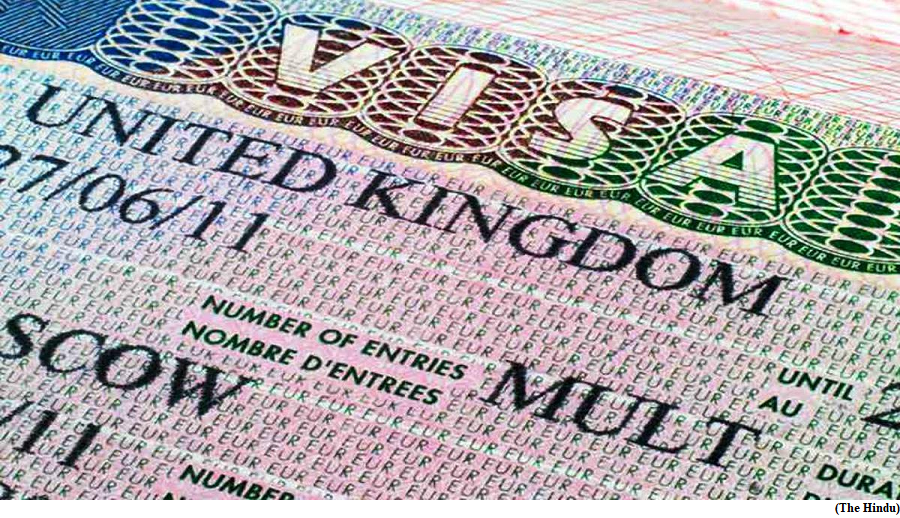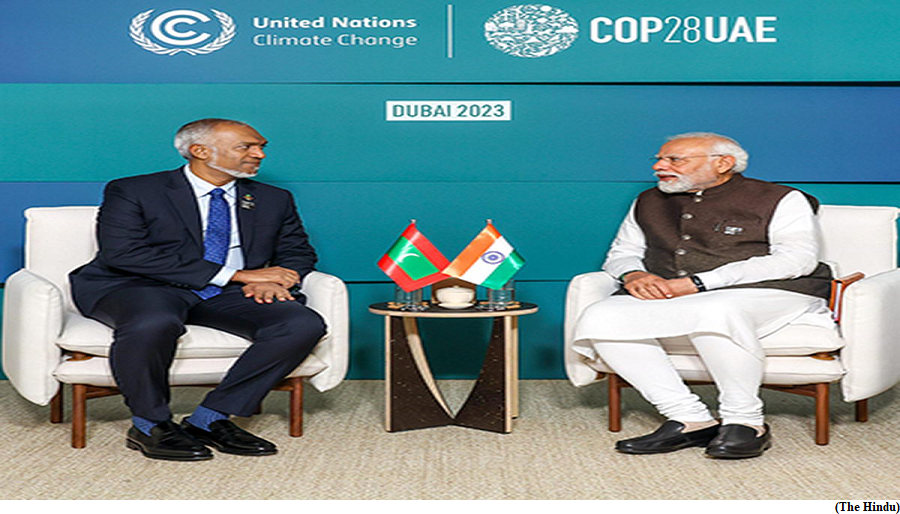How is the U.K. cracking down on immigration? (GS Paper 2, International Relation)

Why in news?
- The government of the U.K. recently proposed new immigration rules to cut the net flow of immigration to the country, primarily by tightening visa requirements across several categories of workers seeking to move to the U.K. from abroad.
- Immigration policy has always been a key policy plank for the government headed by the Conservative Party, and there has been concern that in recent years the number of those immigrating to the U.K. compared to those emigrating abroad has risen sharply.
Why is the United Kingdom tweaking its immigration rules?
- According to the U.K.’s Office for National Statistics (ONS), net migration into the U.K. touched a record high of 7,45,000 in 2022, with reports suggesting that the number of work permits issued to foreign technology professionals in particular rose from 39,899 in 2021 to 52,686 in 2022, marking a five-year high.
- Specifically, it was the category of web design and development that saw the largest percentage increase with 76% more work permits issued during this period.
- Of the 11,80,000 people who entered the U.K. during the year ending June 2023, with the intention to stay for at least one year, the greatest majority of migrants came from outside the EU.
- According to the ONS, students comprised the largest cohort of non-EU migrants, both in 2023 and 2022. However, the proportion of workers arriving to take on roles in healthcare, to make up for the severe staff shortage in the NHS and social care, have also been rising steadily.
- The nations that sent the most migrants to the U.K. from outside of the EU were, in order, India (which sent 2,53,000 people), Nigeria (1,41,000), China (89,000), Pakistan (55,000) and Ukraine (35,000). Of these individuals, a total of 39% entered the U.K. for the purpose of pursuing studies, 33% to work, and 9% for humanitarian reasons.
What are the proposed new regulations?
- The new visa regulations propose to clamp down on the dependents of students arriving in the U.K. as well as other categories of foreign nationals with family ties in the country.
- Skilled workers seeking visas will be impacted by an increase in the minimum salary requirement.
- Health and social care workers, who comprise nearly 50% of work visa migrants, will reportedly be exempt from the increase, suggesting that the maximum impact will be on middle-skilled jobs including those working in the hospitality industry.
- Other changes include a ban on immigrant care workers bringing family members with them, a review of student visas for graduates to prevent “abuse” of the system including a ban on students switching to work visas before completing their studies, and an increase in the immigration health surcharge paid to the NHS by annual fee visa holders, from £624 to £1,035.
What is the broader impact of the proposed changes?
- Following a sharp backlash from immigration advocacy groups, the U.K. government has already walked back its proposal to raise minimum salary requirements for U.K. citizens to bring in non-U.K. family members, reducing the threshold amount from £38,700 to £29,000, “with further increases at unspecified dates thereafter.”
- Meanwhile advocacy groups such as Reunite Families, are said to be exploring legal avenues to challenge the proposed new immigration rules which amount to being “punished for falling in love”.
What’s the latest blip in India-Maldives ties?
(GS Paper 2, International Relation)
Why in news?
- Earlier in December, the Maldives Cabinet decided against renewing a Memorandum of Understanding (MoU) with India for cooperation in hydrography. The agreement, which was signed in 2019, is due to expire in 2024.
- Coming soon after newly elected President Mohamed Muizzu’s pledge to send back Indian troops currently stationed in the Indian Ocean archipelago, the move was yet another indication of his government’s intention to reverse the former Ibrahim Mohamed Solih administration’s ‘India first’ policy.

What is hydrography?
- It is the science of studying oceans, seas, and other water bodies, by compiling and analysing data, maps, and charts.
- It looks at measuring and describing the physical attributes of water bodies and predicting how they might change over time.
- While it is said to be undertaken primarily for safety of navigation, it also supports other activities, such as economic development, security and defence, scientific research, and environmental protection. Hydrographical measurements include tidal, current and wave information.
What is India’s expertise?
- India has been an active member of the International Hydrographic Organization (IHO) since 1955. The Indian Naval Hydrographic Department (INHD) was established in 1874 in Kolkata. It is the nodal agency for hydrographic surveys and has a fleet of indigenously built modern survey ships.
- India partners with many countries in the Indian Ocean Region and African and East Asian countries such as Mauritius, Seychelles, Tanzania, Maldives, Mozambique, Vietnam, Myanmar, Kenya, and Sri Lanka.
- The INHD’s role has broadened over time, owing to the heightening global character of hydrography and “its growing potential as a force multiplier” in terms of maritime diplomacy. Personnel from 39 countries have trained at the National Institute of Hydrography, functioning under the INHD.
Why was the 2019 MoU significant?
- The MoU was signed in June 2019, during Prime Minister Narendra Modi’s state visit to the Maldives.
- It was his second visit to the Maldives since he participated at President Solih’s swearing-in ceremony in 2018.
- The first meeting of the Joint Commission on Hydrography was held in the Maldives in September 2019.
- Following the agreement, the Maldives National Defence Force (MNDF) and the Indian Navy have carried out three joint hydrographic surveys in 2021, 2022, and 2023.
Why has the Cabinet decided against renewing the agreement?
- The decision was aligned to the current administration’s pledge to terminate all agreements with foreign parties that are detrimental to or endanger the national security of the Maldives.
- The message appeared to be in line with new President’s broad election campaign, pledging to remove Indian troops from the country and “restoring the Maldives’s sovereignty”.
- Once he assumed charge, the core demand of the ‘India Out’ campaign led by former President Abdulla Yameen, found mention in President Muizzu’s first set of official announcements.
What does this mean for India-Maldives ties?
- Going by recent developments, it appears as if India will have to brace for a challenging phase of its Maldives partnership.
- Maldives is a member of the Colombo Security Conclave, an initiative aimed at enhancing Indian Ocean maritime security, that includes India, Sri Lanka, and Mauritius.
- However, the Maldives skipped the latest round of the Conclave’s NSA-level meet held in Mauritius.
- It coincided with Maldivian Vice-President Hussain Mohamed Latheef’s visit to China, to attend the China-Indian Ocean Region Forum on Development Cooperation, where he said the Maldives was “eager to explore novel avenues of collaboration and cooperation with China”.
El Nino effect, Cases of dengue have increased globally
(GS Paper 2, Health)
Why in news?
- There has been a ten-fold increase in dengue cases between the years 2000 and 2019, according to an analysis by the World Health Organization (WHO).
- The reported cases have gone up from 500,000 to 5.2 million during this period.
- The actual number of cases would be higher as the infection is asymptomatic in most cases and it is not a notifiable disease in many countries.

Key Highlights:
- There is a sharp increase in cases globally after the lull between the pandemic years 2020-2022. In 2019, when the last spike in cases occurred, the disease was reported in 129 countries.
- In 2023, 80 countries reported over five million cases and more than 5,000 dengue-related deaths.
- Between January 1, 2023 and December 11, 2023, a total of 4.1 million suspected dengue cases, including 6,710 severe cases and 2,049 deaths, were reported from 42 countries and territories in the region.
Regions affected:
- Active outbreaks were reported from 15 countries in the Americas, with Brazil reporting the highest number of cases, followed by Peru and Mexico.
- In the Southeast Asia region, 10 out of 11 member states are known to be endemic for dengue virus. Bangladesh and Thailand recorded a larger number of cases.
- The Africa region was affected by many arboviral diseases, such as yellow fever, dengue, chikungunya, O'nyong nyong, Rift Valley fever and zika.
- In 2023, outbreaks were reported in 15 of the 47 countries in the African region as well. Burkina Faso with 146,878 suspected cases and 688 deaths among suspected cases was the worst affected.
- WHO’s Eastern Mediterranean region first reported dengue cases in 1998. Since then, the virus has spread to nine countries. Pakistan, Saudi Arabia and Oman have reported the highest number of confirmed cases thus far in 2023.
- The European Region was not affected much and earlier cases used to be mainly travel-related. However, since 2010, the disease has established itself in the region. In 2023, cases and outbreaks have been reported in three countries: Italy, France and Spain.
- In 2023, the Western Pacific Region has reported over 500,000 dengue cases and 750 deaths The most affected countries are the Philippines and Vietnam. Among the Pacific Island countries, Fiji is the worst affected.
Factors responsible:
- In 2023, the upsurge can be linked to the changing distribution of the vectors (chiefly Aedes aegypti and Aedes albopictus); increase in temperature and changes in rainfall patterns due to the El Nino climate phenomenon; fragile health systems after the pandemic, political and financial instabilities in countries; and high population movements.
Dengue:
- Dengue transmission is cyclic and large outbreaks occur every 3-4 years. Four serotypes of the virus (DENV-1, DENV-2, DENV-3, DENV-4) are present.
- There is no specific treatment for dengue, but severe cases and mortality can be prevented with timely diagnosis and appropriate clinical management.
Way Forward:
- There is an urgent need to increase advocacy and resource mobilisation.
- A Global Joint Incident Management Support Team has been established involving the WHO Health Emergencies Programme (Response and Preparedness departments) and technical expertise from the neglected tropical disease department to support the response to outbreaks.




